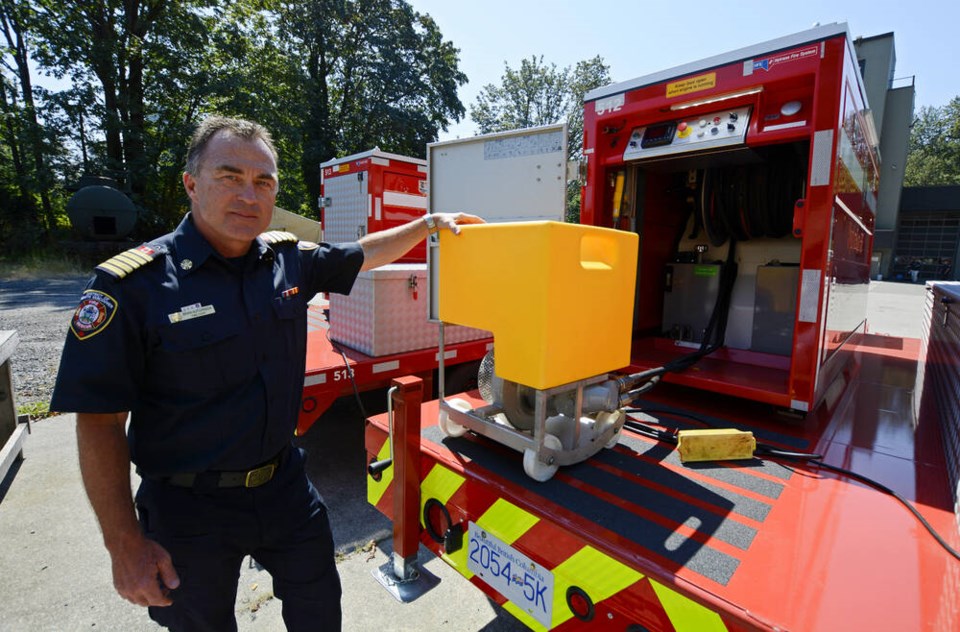Emergency response capabilities are about to take a quantum leap on the North Shore.
A new pair of portable water pumps purchased by District of North Vancouver Fire and Rescue Services give local first responders a massive boost to firefighting capabilities, but also to flood relief and other disaster scenarios.
Two Hydrosub 60 units are now in the hands of district firefighters. The mass water supply systems can be deployed in remote areas without hydrant infrastructure, and where other methods are less effective or feasible.
District fire Chief Brian Hutchinson says a wildfire that broke out in the Woodlands community in 2020 prompted his department to review capabilities to provide firefighting services in the area, which is just north of Deep Cove. One of the units is slated to be stationed nearby up Indian Arm.
“We’ve always been aware of some of the limitations of response capability out in that area,” he said. “But we also looked through the bigger lens, and we said, ‘OK, we have over 5,000 homes in our wildland-urban interface. What are the hazards in terms of being able to fight fires effectively?’”
In North Van, there are plenty of natural water sources – rivers, streams, shoreline – but in very few of these cases can you actually get a firetruck close enough to draft water, Hutchinson explained. Even at a place like Whey-ah-wichen/Cates Park, for example, you’ve got two big trucks parked there trying to draw water from the ocean. If the tide goes out, you’re out of luck. If it comes in, the trucks could be swimming.
With the Hydrosubs, you send out a small floating device called the submersible pump on a 150-foot line. Fixed to its attached diesel “powerpack,” the combined unit is capable of pumping over 1,000 gallons per minute at high pressure. The hydraulic pump pushes the water up to the fire truck, basically fulfilling the role of a fire hydrant.
The units, which cost around $175,000 each, are also uniquely portable and can be air-lifted by Talon’s Dauphin helicopters.
“When we purchased them, we wanted to make sure we had the capability if we needed to deploy to, say, Indian arm – no road access – we can either put the trailer on a barge or we can unhook it from the trailer, and we’ve got the lifting hooks on the top,” Hutchinson said. “Talon could actually fly it up there for us.”
The fire chief said that the Hydrosubs allow the district to be proactive in fighting a growing threat of wildfires in the region. Historically, the North Shore’s coastal forest doesn’t see a large volume of wildfires compared to interior areas of B.C.
“But what we’re seeing with the impacts of climate change, with the heat domes, is that our forests are stressed, and are becoming more susceptible to wildland fires,” he said. “We have a lot of people utilizing that resource.
“It’s an extremely valuable resource for us. We don’t log it. But it is part of who we are as a community. It’s what draws people here. And it’s worth making sure that we’re protecting it, and the homes and infrastructure that are immediately adjacent to it, too.”
Vancouver is one of two other municipalities in Canada that has a Hydrosub as well. But Hutchinson said Vancouver’s much larger unit is intended to be used in post-disaster scenarios, such as an earthquake that could take out the domestic water supply. In that case, the device could be used to provide water all over the city.
North Van’s pumps could be used for the same purpose. At lower pressure settings, they can pump out more than 5,000 gallons per minute. That capability also makes them a valuable tool in responding to floods, which are common in the Netherlands where the Hydrosubs are built.
Hutchinson said training is rolling out, and should be ready for deployment in six-to-eight weeks.




